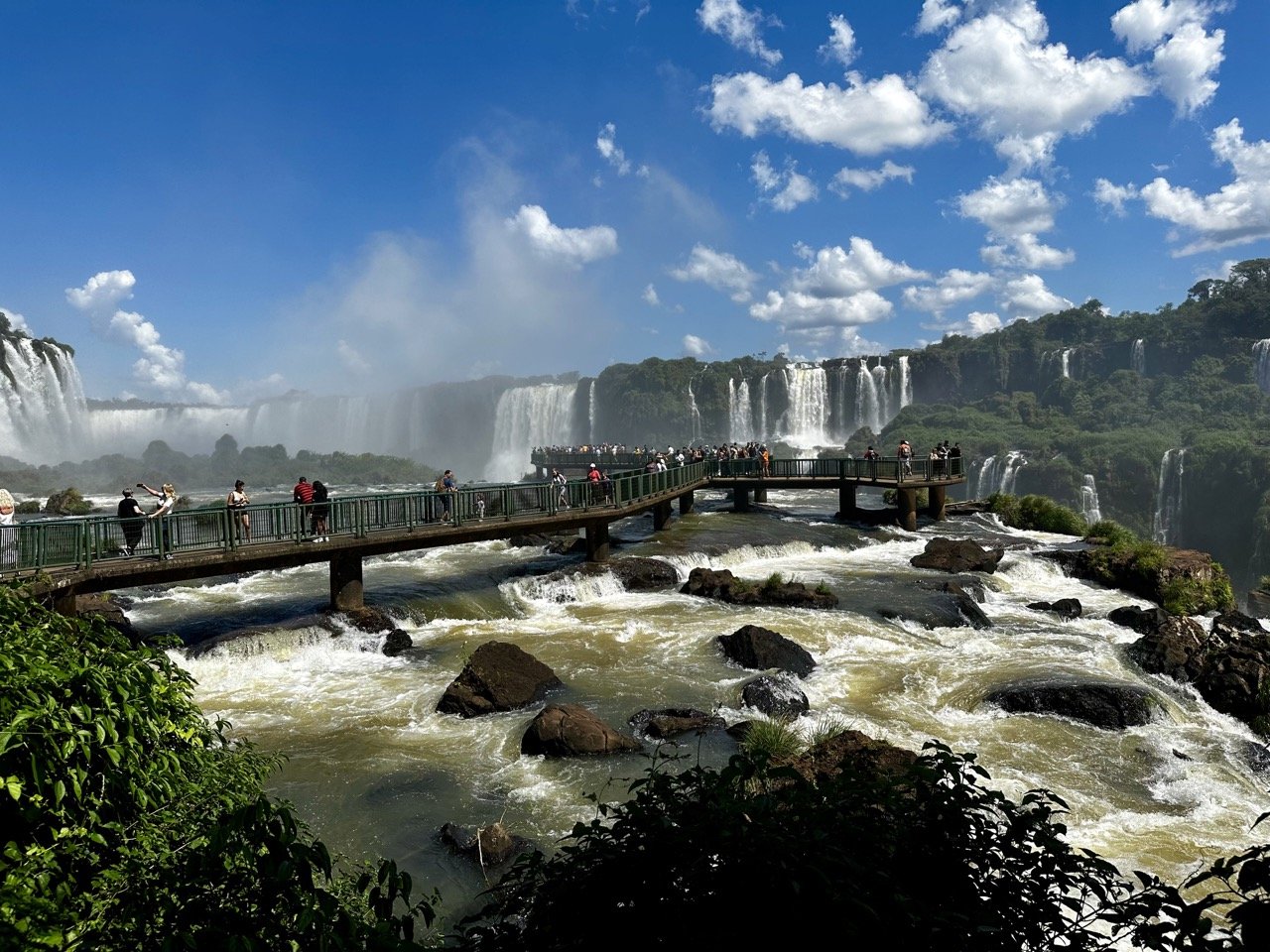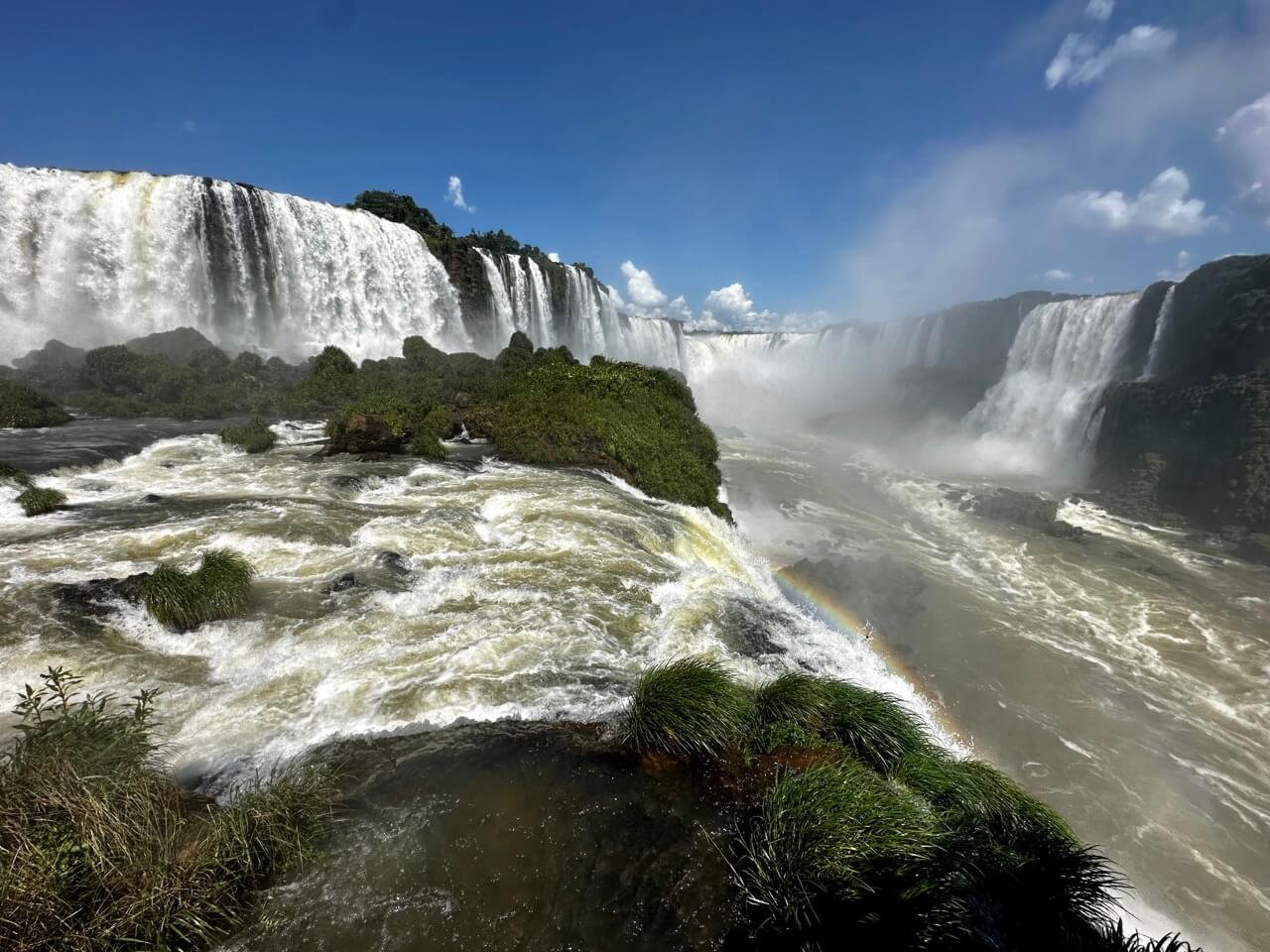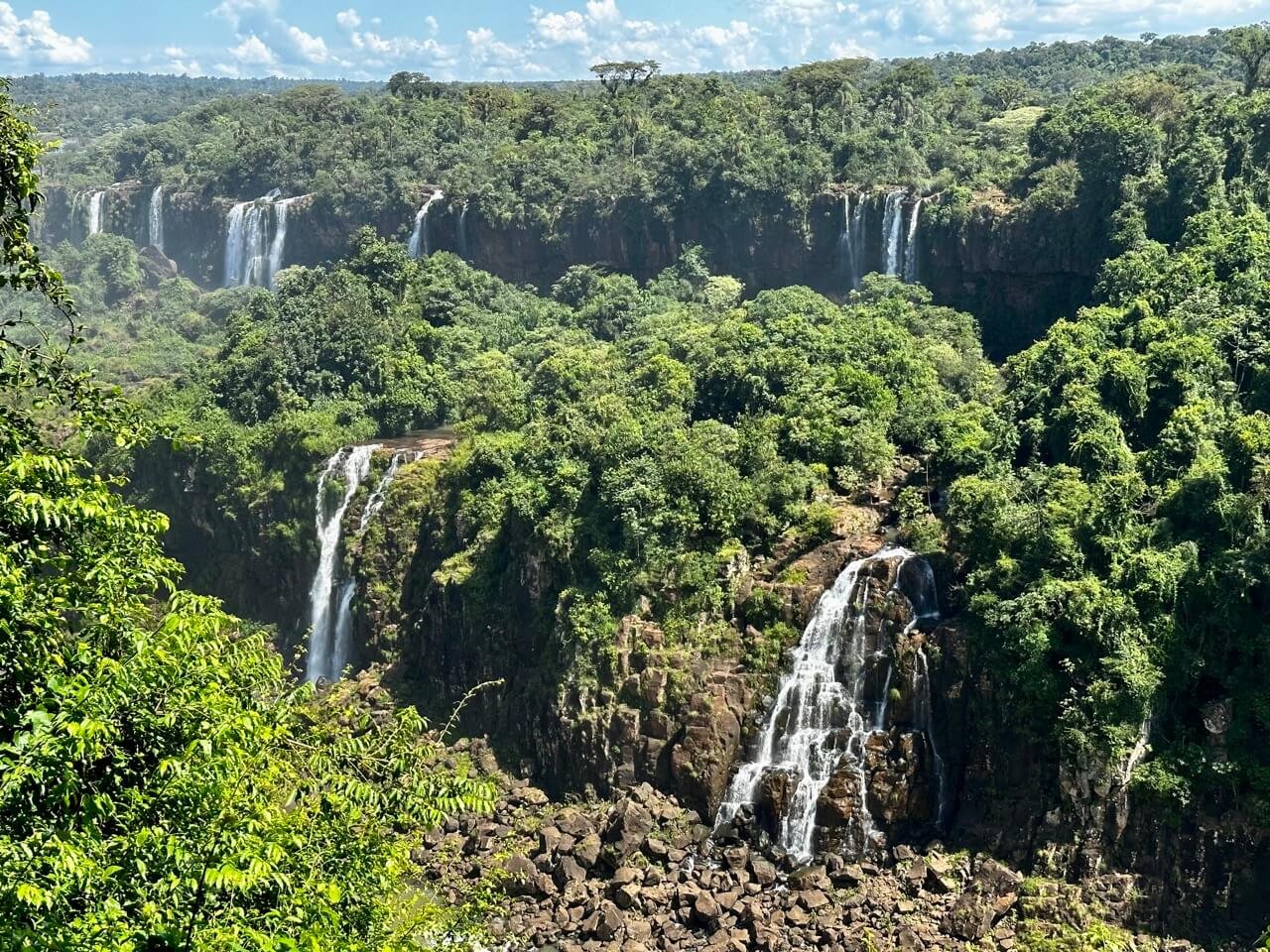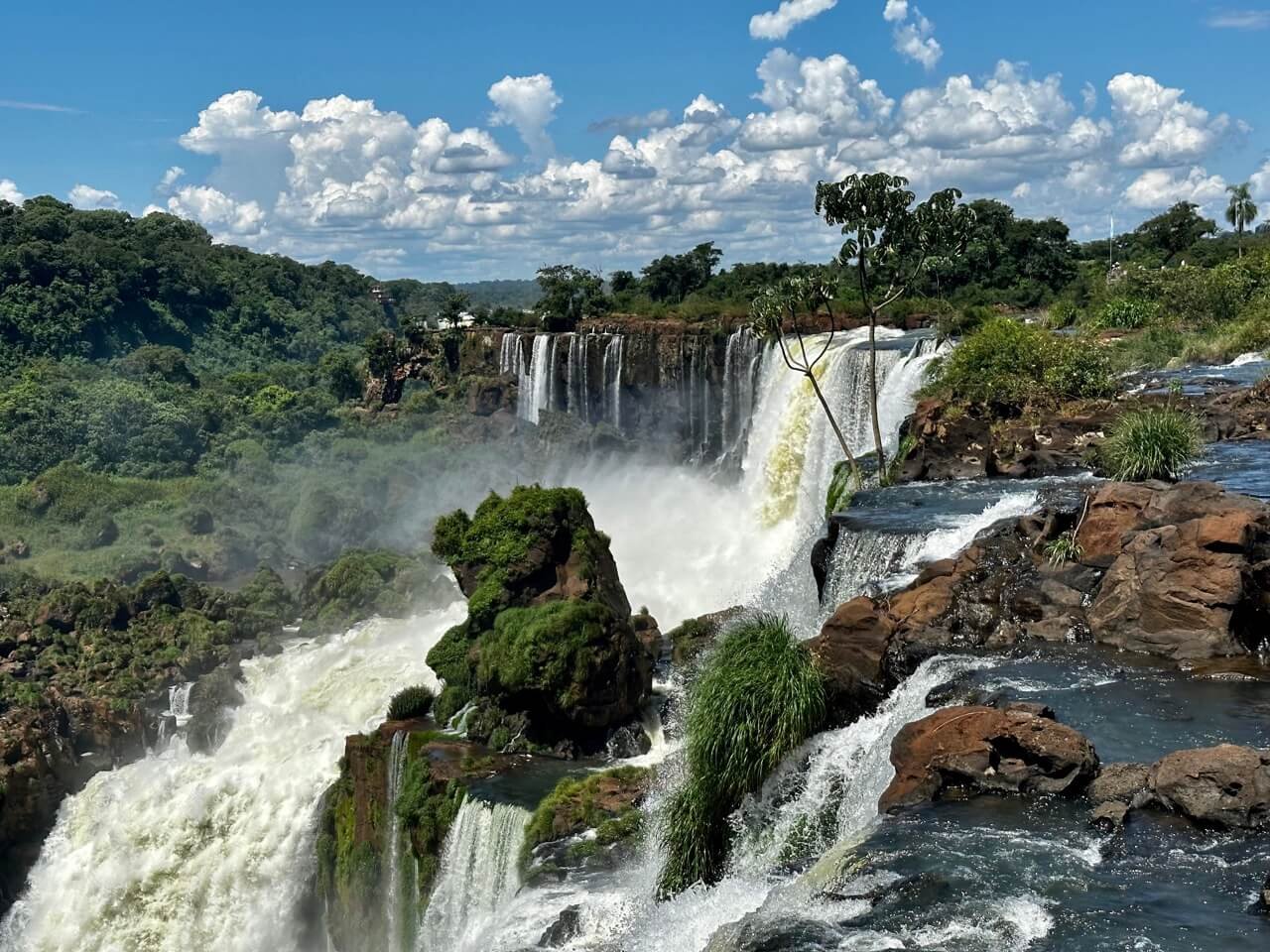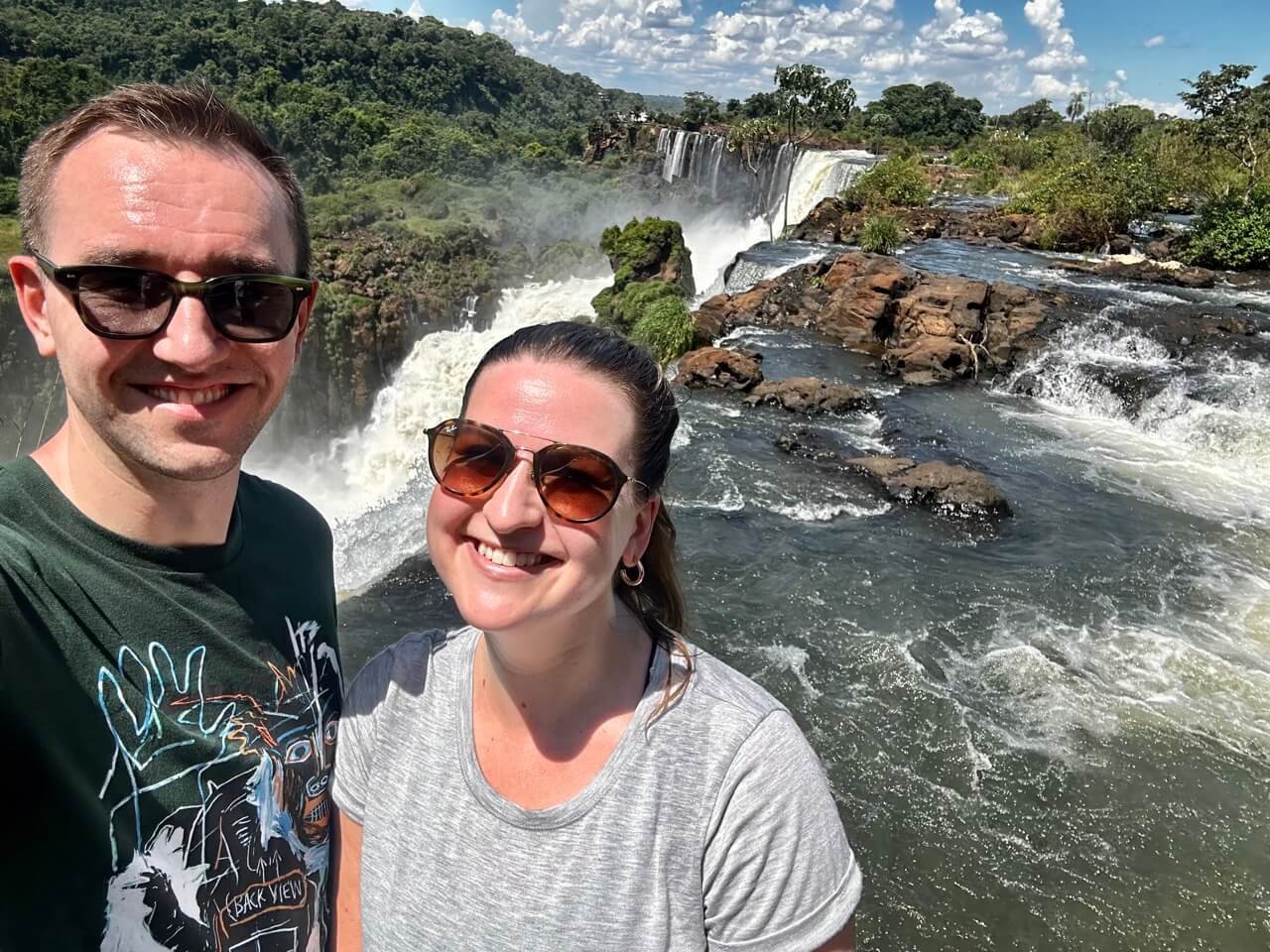How to Take a Self-Guided Tour of Iguazu Falls: Make the Most of Visiting this Iconic Landmark Straddling Argentina and Brazil
We recently visited both the Brazilian and Argentian side of Iguazu Falls and have put together a complete guide for you to take a self-guided tour of Iguazu Falls. Bri Mitchell walks you through your own potential visit, step by step.
The boardwalk on the Brazilian side which you can walk out upon and snap some fantastic photos.
Iguazu Falls is one of the most notable natural wonders of the world, and for good reason. Wandering its grounds is the stuff that dreams are made of. Walking through the myriad of boardwalk pathways, peering through rainforest foliage to discover waterfalls pouring every which way, and seeing rainbows being cast across waterfalls with butterflies flitting to and fro feels otherworldly.
If you are planning a trip to Argentina, you definitely want to carve out some time for a self-guided tour of Iguazu Falls in addition to visiting some other incredible parts of the country. Visiting Salta Province, Jujuy, Mendoza and Buenos Aires are all highlights in our books—and there are so many other places to go beyond that list throughout the country and the rest of South America.
There are a few different ways to get to the region of the Falls (which we’ll talk about in more depth down below). Once you get here, you definitely want to ensure that you can fully appreciate and explore this natural wonder.
Please note that this post contains affiliate links. Simply put, this means we may a small commission for some of our honest recommendations at zero additional cost to you.
Where to Stay in Puerto Iguazu
When you’re staying in Puerto Iguazu, it’s best to stay near the central bus station. Travelling by bus is essential to visiting both sides of the falls, and taxis are quite expensive to get around town.
There are many resort-style hotels that are further away from the bus terminal. Before you book in at one of these hotels, check to see if they offer transfers to the bus terminal, or other parts of the town, to help you get from place to place.
Regardless of your budget when booking accommodation in Puerto Iguazu, make sure you double check your home base will have air conditioning. You’ll want to be able to cool off after long days spent exploring the falls in the hot, hot heat.
Chris and I were really pleased with Marin Apartments. It is less than a ten-minute walk to the bus station, and there are six different apartments in the same building to rent. They are all equipped with ample air conditioning, multiple bedrooms, a full kitchen and a spacious living area. When we came back from our long and hot days exploring Iguazu Falls, we were really grateful to have booked such a comfortable place. The host is also very generous and kind, with a lot of knowledge to offer about Puerto Iguazu.
Why Iguazu Falls Needs to Be on Your Radar
Iguazu Falls attracts millions of visitors every year. It is an official “Wonder of Nature”, or one of the natural wonders of the world. It’s also a UNESCO World Heritage site, and will be protected for years to come.
Having seen many waterfalls in my time, it’s pretty clear why they are a wonder. Despite Victoria Falls (Zambia/Zimbabwe) and Niagara Falls (Canada/USA) possibly being more famous than Iguazu Falls, the Iguazu Falls are taller than Niagara Falls, and wider than Victoria Falls. This quite possibly makes them the most awe-inspiring falls in the world.
Another amazing quality of the falls is when you walk along the boardwalk (pictured above) on the Brazilian side, you can almost entirely be surrounded by waterfalls. It’s a 260 degree span at the narrowest point, which makes you feel like you’re being hugged by the falls.
Similarly to both other sets of falls, Iguazu Falls straddles a border between two countries. The falls are accessible from both Brazil and Argentina, with very different vantage points on either side. You should definitely plan on spending time visiting both sides of the falls during your visit, so keep reading to understand why.
Iguazu Falls is especially impressive because of the sheer volume of water rushing over the falls on both sides of the border.
How to Get to Iguazu Falls
You can get to Iguazu Falls in a few different ways. The best way that I’d recommend is linking your trip to the falls to a trip to Argentina at large, and visiting Iguazu Falls from Buenos Aires. You’re going to want to plan your accommodation for Puerto Iguazu, the Argentinian town that’s closest to the falls.
You can also access the falls from the Brazilian side. The Brazilian side is a little more developed in terms of the scale of resorts that have been put up around the falls, and it is another nice place to stay.
What to Wear and Bring on a Self-Guided Tour of Iguazu Falls
If you are planning to make the most out of your time on a self-guided tour of Iguazu Falls, then there are a few items you want to ensure you wear and take with you.
I’ve created a list here with the items I’d recommend bringing, including some links to the products that have worked best for me.
Comfortable walking shoes. This is likely the most important thing to bring on a trip to Iguazu Falls. Although you might get wet, on your visit, there is a lot of walking on these travel days, so it’s important to prioritize good shoes. I have been loving my Reebok vintage walking shoes lately. They are available in both women’s and men’s sizes. They are extremely comfortable (I am prone to blisters) and true to size, and I can’t recommend them more as a nice, stylish shoe for your upcoming trip.
Breathable, functional clothing. Depending on the time of year you visit, the temperature will vary slightly at Iguazu Falls. Since you’ll be doing a lot of walking, you want to pack comfortable, breathable and sweat-wicking clothing. I’d recommend finding a pair of men’s or women’s hiking pants. These will help keep you cool during any season. I am personally a fan of travelling with bike shorts in the hotter months of the year, which is what I wore when we visited the falls in March. I’d also recommend a boat-neck men’s or women’s t-shirt, which will prevent you getting sunburned while you’re enjoying the falls.
A hat. The sun can be punishing all times of year at Iguazu Falls. If you’re sensitive to heat stroke, or just want a little extra protection from the sun, bringing a good hat is definitely recommended.
A small daypack with some main essentials. A day pack on long travel day trips like these is always a must. Sometimes it’s tricky to bring a daypack in addition to your other luggage, so I always like to recommend bringing a packable daypack that you can use for day trips. They pack up small, making it easy to pop into your luggage before a trip. I’d recommend packing the following in your daypack for a self-guided tour of Iguazu Falls:
Water bottle. Bringing a reusable water bottle is essential, even if the local tap water isn’t recommended to drink, like in Puerto Iguazu. A filtered water bottle like this LifeStraw is the best, because you can use it in places where the water isn’t safe to drink.
Sunscreen. I am never without travel sunscreen, especially in warm climates. Having an environmentally friendly kit like this includes everything you’ll need while you’re on the road. If you’re just looking for a reliable, sweat-resistant sunscreen, then I find this brand to be the most reliable.
Sealed snacks or energy bars. Having something quick that you can eat in a pinch if you’re feeling hungry is important for any major travel day. It’s especially important to have food or snacks you can eat quickly while at Iguazu Falls, because of the coatis. Coatis are cute little curious members of the raccoon family who live in South America. Due to the high concentration of coatis, they can tend to descend on tourists if they smell food, and become quite aggressive. This is why sealed snacks on-the-go are the most important. A quick snack is best to avoid animals bothering you, and always be sure to never feed wildlife anywhere you travel. There are snack bars and refreshment stands throughout both parks on either side of the falls, but they are quite spread out, and I found their options for nutritious or protein-filled snacks limiting. You don’t want to have to rush through some beautiful views in the event that you urgently need water or a snack.
Electrolyte Packets. Especially if you’re visiting Iguazu Falls in the hottest months of the year, you need to ensure you stay hydrated. I like to bring these hydrating electrolyte packages on all of my day trips, in case I feel like I need a boost of energy and hydration when I’m really active in hot temperatures.
Poncho. Since a visit to Iguazu Falls will most likely be warm, a poncho is a nice thing to have at the ready. I found it really refreshing to be misted by the falls, and nothing in my daypack got wet. Visiting during the winter months, however, typically means that there will be more water coming down from the falls, which might make for more wet conditions. Throwing one or two ponchos into any daypack is never a bad idea, since you never know when you’ll need them.
The Best Time to Visit Iguazu Falls
The falls are flowing all year round, so you can visit them whenever you want, but the two best times in the year to visit are from late March to May, or August to early October. The season from March to May has warm but reasonable temperatures, an abundance of sunshine and less chances of rain. August to October is another dry season, with the “coolest” (25/26 degrees Celcius) temperatures, and lower risk of rainfall.
In the summer months (December to February) and the months shouldering this time, the falls are at their fullest, but it can be very hot at the falls. If you are sensitive to the heat, this is something to think about, since visiting Iguazu Falls requires a considerable amount of walking. When we visited in mid-March, any time between 11am and 4pm was still extremely hot. The conditions are humid, and the temperature often goes up to 34 degrees Celcius or more.
The winter months (June to August) are still quite warm, with temperatures averaging around 28 degrees Celcius during the day. Considering the falls are always flowing, something to consider is the likelihood of rain on your trip to Iguazu Falls. Any sort of rainy or foggy conditions can make for next to zero visibility. This is another reason you want to make sure you have a few days planned to visit Iguazu Falls on your trip.
Planning a Self-Guided Tour of Iguazu Falls: How Many Days is Enough?
Regardless of which side you visit during your self-guided tour of Iguazu Falls, you definitely need to carve out enough time to see the falls from both sides. This means that you need to give yourself at least two complete days during your visit to take them in.
I’d recommend spending your first full day visiting the falls from the Brazilian side. The Brazilian side offers the iconic panoramic view that you often see when you look at pictures of the Iguazu Falls. This isn’t to say the Argentinian side is not worth it—on the contrary, it is worth a full extra day, at least. The Argentinian side is full of boardwalks that weave in and out of the falls themselves, bringing you an up close and personal view, and a memorable experience.
Is it Easy to Cross the Border to Iguazu Falls’ Brazil Side?
Despite thinking this would be a complicated process, it was one of the easiest border crossings I think I’ve ever done. If you are planning to visit Iguazu Falls on the Brazil side, continue reading this section.
If you will only be staying in Argentina, you can skip to the end. That being said, if your passport allows it and you have the time, it is definitely worth taking in this site of Iguazu Falls from Brazil.
How to Get to Iguazu Falls’ brazil Side
Start by checking if your passport requires a visa to enter Brazil. Some countries don’t require a visa, but it changes frequently. Ensure you have your passport with you for the trip.
Book a bus ticket with one of the local companies in Puerto Iguazu to take you to the Brazilian side of the falls. We recommend booking with Rio Uruguay, but there are other companies, too. From the bus terminal in Puerto Iguazu, the Rio Uruguay buses leave every hour on the half hour mark.
Make sure you are at the platform a couple minutes early for your bus, because the buses in Argentina tend to leave quickly. They won’t wait for you if you purchased a ticket, but you ran to the bathroom before departing.
How to Cross to Iguazu Falls’ Brazil Side
When you leave the Argentinian side to see Iguazu Falls from the Brazil side, the bus stops at the border crossing on the way. All people from the bus get off, and the immigration terminal has two lines: one for Argentinian nationals, and one for nationalities of other passports.
If you checked all the requirements for how to enter Brazil on your passport, you shouldn’t run into any issues at the border. If a visa is necessary before visiting the falls, ensure you apply well in advance of your trip.
Getting Off at the Right Stop on the Brazil Side
Once you pass the border, the Rio Uruguay bus makes a few stop on the Brazilian side of the border. Our bus stopped at a bird sanctuary and a picnic area before getting to Iguaçu National Park in Brazil.
When you arrive at the park, make note of the return times for Rio Uruguay to head back to Puerto Iguazu in Argentina. The buses also leave every hour on the half hour mark. It’s worth taking a picture or making a mental note of where the bus drops you off, since this is where you’ll depart from on the way back.
Buying Your Ticket to See the Falls from the Brazil Side
It’s very easy to buy a ticket to the park when you are taking a self-guided tour of Iguazu Falls. There are ticketing kiosk machines set up close to where the bus drops you off.
If you are visiting during a larger trip to Argentina and don’t have any Brazilian Reals, there’s no need to worry. All of the vendors in Iguaçu National Park accept all major credit cards. This is a relief, because you don’t need to worry about finding cash for such a brief trip to Brazil.
Unfortunately many major credit card companies (especially in Canada) charge you a fee for each purchase if you use a card internationally. If you travel internationally a few times per year, we’d highly recommend signing up for a credit card with no foreign transaction fees, so you don’t fall prey to this on your trip.
Seeing Iguazu Falls: Brazil Side
It doesn’t matter how many pictures you see or how much research you do prior to your visit—the awestruck feeling of seeing Iguazu Falls from the Brazilian side for the first time is one of those “pinch me” moments in travel. This is because the falls are mostly on the Argentinian side, so seeing them from Brazil means you get the full scope of them from a birds-eye view.
How to Get to Iguazu Falls By Bus
After you buy your ticket at Iguaçu National Park, join the line for one of the double decker buses. Try to get a spot in the open-air top deck if you can, since it drives through the rainforest canopy. The bus takes you on the 10 kilometer drive through the jungle to different areas to explore the park further.
The first stop on the bus is better for an extra day at Iguazu, or for later in the day if you arrived early on the Brazilian side. You can pay extra for an open air off-road vehicle tour of some of the more rugged paths of rainforest behind the falls. Although we didn’t take this tour, it sounds like a great experience, and is a nice opportunity to understand more about the plants and animals that live in the surrounding jungles.
Walking Along the Iguazu Falls Brazil Side Boardwalk
Get off at stop two on the bus, unless someone in your party isn’t mobile or has a challenging time walking. This stop brings you to the start of a boardwalk that is around a kilometer long. It takes you past all of the views of the falls from the Brazil side, and is an excellent opportunity to capture photos of the falls, and even meet some coati.
This path is well-marked, with bathrooms and food and refreshment stands along the walk. If you’re eating something, or drinking something sweet, keep a close eye on the coati. They aren’t scared to get up close and personal to ask for food or drinks. Despite us being careful, one even stuck his nose in my open water bottle, which I had to forfeit for the day. They are cute, but they easily get into trouble.
Walking along this path was definitely one of the highlights of our trip to Iguazu Falls. At the end of the walk, you are taken to a raised platform directly beneath the main crescent of the Argentinian and Brazilian falls. Seeing the falls from so close and on all sides is a powerful and freeing moment. It’s magical to see Mother Nature in all of her glory here.
Getting Back to the Argentinian Side
After you’ve walked through the boardwalk and surrounding areas, this brings you to the end of the path. There are bathrooms and snack bars at the end, with views of the falls. Take a look at the clock to decide if it’s worth hopping on the bus back to the main entrance quickly. We did this, and were glad we did, because the bus ride back took about 20-25 minutes.
If you need a snack while you wait for your bus home, there are several places at the main entrance that you can go to. From there, go back to where the Rio Uruguay bus dropped you off to get back to Argentina and Puerto Iguazu.
How to Get to Iguazu Falls: Argentina Side
On day two of your visit to Iguazu, this is your chance to get more up close and personal with the falls. Although walking along the raised platform on the Brazil side is exhilarating, the boardwalks that lead in and out of jungle and falls views on the Argentinian side make you feel a little more like an explorer. There will be many moments taking in the falls from this side where you’ll feel like you’re wandering the grounds in an epic movie, like Jurassic Park.
How to Get to Iguazu Falls National Park By Bus
Taking buses in Puerto Iguazu is the best way to get around efficiently. I wouldn’t recommend taking a taxi across to the Brazilian side because of customs. But if you’re more interested in private transportation to get to Iguazu Falls on the Argentinian side, then you can take a taxi for about 4500 pesos one way (at the time of publication). Make sure you have a plan for how to get back by taxi. Perhaps arrange with your driver in advance to pick you up on the way back.
Similarly to day one, start your day early and head to the Puerto Iguazu bus terminal. We’d recommend booking another ticket with Rio Uruguay. Like travelling to the Brazil side, you’ll get both sets of tickets when you purchase them here, and make sure you’re nearby the platform for your scheduled bus departure. The bus ride takes about 30 minutes from the bus terminal to the National Park.
Entering Iguazu Falls National Park
Once you arrive at the Argentinian side, there is a little ticketing area where you buy your entry ticket for the day. Whereas the Brazilian side of the falls is a little more modernized and developed, the Argentinian side is more on the “old school” and rugged end of things. We actually enjoyed this element of it, but it means you need cash to pay for your entry to the park. The same goes for snack stands. If you don’t have enough cash, there are ATMs on site.
At the time we visited, the entry fee was around 4700 ARS (approximately 22 USD). In addition to stopping for snacks or drinks throughout the day, make sure you plan accordingly.
Planning Where to GO on a Self-Guided Tour of Iguazu Falls in Argentina
Once you enter the park, there are several different types of trails to take. I’d recommend carving out enough time to see the first three, and then if you have extra time you can include the others, too:
Standing near Devil’s Throat on the Argentinian side.
Devil’s Throat: This is the most popular and famous of the trails on the Argentinian side of the park. It’s at the far end of the park, and you need to take the train inside the park to get to its entrance. This path will take you right to the main crescent of the falls, and if you visited the Brazilian side the day before, you’ll be up above the falls looking down on where you were yesterday. It is incredible to see these falls from this vantage point, and well worth visiting. There is a snack bar near where the train drops you off. If you have more time, definitely check out some of the next trails, too. It will likely take you about 1.5 hours to visit this trail, including the train.
Superior Circuit: This is one of two boardwalk trails that weave between the falls on the Argentinian side. Both trails are worth visiting, but if you have time to only choose one, this one is likely the more impressive of the two (although I have a soft spot for the Lower Circuit). It takes you along the top of all the falls, and in the parts between them. It can be busier than the Lower Circuit, so try to strategize passing people to get your own personal viewpoints. The whole trail takes about 1 hour.
Lower Circuit: If you have time for this trail and the two above, please start with the Lower Circuit, followed by Superior, and finish with Devil’s Throat. The Lower Circuit isn’t as busy as the other two trails, and you are kind of in the middle of the falls as you walk through the rainforest canopy. It’s really impressive. Between the jungle greenery that falls around you, rainbows coming from the waterfalls and little butterflies flying around, the opportunities for great photos are endless.
Green Trail: This is a nice little trail to take if you don’t want to only take the train throughout the park. It takes you from near the main entrance areas and shops to the entry point to paths 1, 2 and 3. It’s a quiet path with natural greenery all around.
Macuco Trail: This is a long, untouched trail that goes into the rainforest. If you are interested in bird watching or finding animals native to the region while walking through a forest canopy, then this is the trail you’ll want to take. It’s hard to predict whether you’ll cross paths with other animals, but you have a good chance of doing so here. Make sure you have enough to drink, as it’s a remote trail, and will take you around 2 hours to walk through.
Planning Your Time on Extending or Leaving the National Park
As you’re making your way around the park, make sure to remember that if the visibility is poor during your visit, or if you didn’t get to see as much as you had hoped, you can come back. If you check in with one of the attendants as you leave, they will stamp your ticket so you can come back the following day at half price.
Taking the buses back to Puerto Iguazu is easy, and they come every 20 minutes. Just keep in mind that many visitors will want to board the return bus along with you, so you may have to wait in line a little bit. Either way, it isn’t long to wait around if you have to.
Finishing Up Your Self-Guided Tour of Iguazu Falls
The Jurassic Park like aesthetic at Iguazu Falls (Argentinian side).
Once you’ve gotten your tens of thousands of steps in across multiple days at Iguazu Falls, you will feel a huge sense of accomplishment. It is an absolutely stunning natural wonder of the world, and you will have many moments where you count your blessings while you see it.
If you’re looking for more things to do in Argentina, we’ll be sharing other thoughts and suggestions about Puerto Iguazu and other regions of the country, like Mendoza and Buenos Aires. We sincerely hope this helps you in your journey!
Bri Mitchell
Bri Mitchell is a travel writer and content creator from Toronto, Ontario. She loves to highlight all things nature, food, wellness, sustainability and adventure in her work. Bri writes and shares her travel experiences from across Canada, the United States and around the world on Instagram and TikTok (@brimitchelltravels), and in her articles for travelingmitch, Ultimate Ontario, and We Explore Canada.




